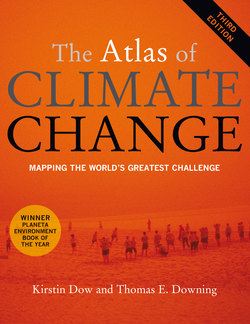Читать книгу The Atlas of Climate Change - Professor Kirstin Dow - Страница 23
На сайте Литреса книга снята с продажи.
ОглавлениеWarming in the Antarctic Peninsula and Arctic is driving large-scale melting of ice that will have both local and global consequences. The presence of a hole in the ozone layer over the southern polar region has altered weather circulation patterns on Antarctica. It has brought more warm, moist, maritime air over the Antarctic Peninsula, contributing to warming and melting there, but has created a cooling effect in other areas. As the ozone hole recovers, that cooling effect is expected to diminish. In East Antarctica, the changes are much less dramatic than those on the Peninsula, with some melting and thinning on coastal edges and some thickening in the interior. In West Antarctica, however, a coastal section of the ice sheet is now thinning quite rapidly. Floating Arctic ice has covered the North Pole for millions of years. Its extent fluctuates with the seasons, but eight of the ten lowest extents have occurred in the last decade. The remaining ice is
also thinner, with approximately 50 percent of the maximum recorded thickness having been lost by 2008. Already, the North Pole is free of ice in some summers. In September 2007, the Arctic ice cap shrank to its smallest recorded extent, opening up the possibility of commercial shipping routes operating for the first time along the northern coasts of Canada and Russia. Some projections suggest that sea ice will disappear completely in the summer months by 2080. While an open Arctic sea would facilitate shorter trade routes, industrial-scale fishing and the exploitation of minerals, it would be at great cost to the environment and to traditional livelihoods. A delay in the formation of the winter ice, an earlier break-up of ice in the spring, and thinner ice year round makes it hard for indigenous people using largely traditional methods to make a living.
Polar Changes
Collapsing ice shelves The collapse of the Larsen A Ice Shelf in 1995 was followed by that of the Larsen B Ice Shelf in 2002. Over the last century nearly 20,000 sq km (7,720 sq miles) of ice shelf was lost on the Antarctic Peninsula.
Melting ice and sea-level rise
Melting of floating sea ice and calving of glaciers into the ocean do not affect the sea level. Ice displaces about the same volume of water as it produces when it melts. However, thinning and retreat of glaciers on land does add water to the oceans.
Wilkins Ice Bridge
This 100-km long strip of ice, which broke apart in April 2009, is believed to have held the remnants of the Wilkins Ice Shelf in place since the shelf’s retreat and collapse in the 1990s. The loss of the ice bridge may allow the ocean currents to disperse huge ice floes.
Floral responses
Two native flowering plants (Deschampsia antarctica and Colobanthus quitensis) have increased in abundance at some sites in the maritime Antarctic, providing clear evidence of terrestrial species responding to climate change.
West Antarctic ice sheet
The Amundsen Sea area is the most rapidly changing section of the Antarctic ice sheet. The annual mass loss from glaciers represents a significant contribution to sea-level rise.
24
